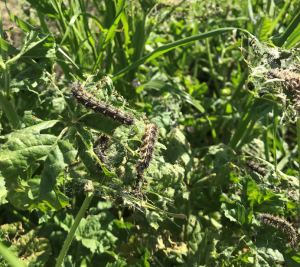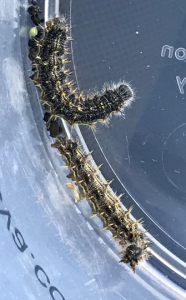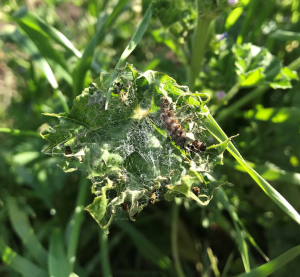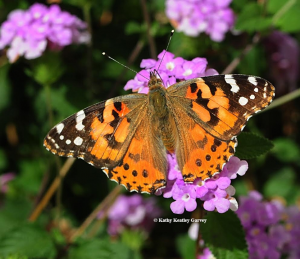This week, I received several phone calls and photos from growers and PCAs in the area inquiring about large caterpillars being observed on weeds in their almond and walnut orchards, often on malva (a.k.a., cheeseweed, mallow) and associated with substantial webbing and frass (caterpillar “poop”).

Painted lady caterpillars and associated webbing and frass on malva (cheeseweed). Photo credit: Sac Valley Orchards. (click to enlarge)
The short answer is that these are late instar larvae of the Painted Lady butterfly (Vanessa cardui) and they do not pose a risk to our orchard crops.
You might remember hearing news stories throughout California about the epic Painted Lady migration earlier this year, or you may have enjoyed watching the adults passing through our area en masse about a month ago. The many Facebook posts around the week of March 21, 2019, tell the story (although many mistakenly identified the migrating butterflies as Monarchs).
The larvae we are observing now are large, dark in color with a noticeable dark stripe along the back and very obvious yellowish “fuzzy-spikey” spines. There can be some color variation in the larval body (gray, grayish-brown, almost black). Based on observations during the week of April 22nd, these are late stage, and should be pupating any day with the ongoing warm temperatures. Once the adults emerge, they will continue their migration north.

Painted lady caterpillars. Notice the distinct yellow “spikes” along the length of the body. Photo credit: Sac Valley Orchards. (click to enlarge)
Because we are experiencing an unusually high population this year, and noticeable presence in our orchard environments, I wanted to be sure that our tree crops are not at risk. This led me to a fun and enlightening exchange with UC Davis “butterfly guru” Dr. Art Shapiro (formal title Distinguished Professor of Evolution & Ecology). Painted ladies migrate north annually from the deserts near the Mexican border, their numbers exploding in years with high rainfall that fuels plant growth. Indeed, one of the most notable high migration years in recent history was 2005, another year with high rainfall totals. According to Dr. Shapiro, “Years of tremendous wildflower blooms typically are really big painted lady years.”
Our primary tree crops (walnuts, almonds, pistachios, etc.) in the Central Valley are not suitable feeding or breeding hosts for Painted Lady, and thus we should not see any injury or damage caused by this species in orchards. In fact, Dr. Shapiro notes that there are ZERO credible records of Painted Lady damage to trees of any kind. I did havea conversation this week with an experienced PCA, who recollected observing Painted Lady caterpillars move into a few trees in a very young and vigorous almond block several seasons ago when populations were high, but the larvae were unsuccessful after some minor “test” feeding (either moved back off of the trees or died).

Late instar painted lady caterpillar and associated webbing on malva (cheeseweed). Photo credit: Sac Valley Orchards. (click to enlarge)
Dr. Shapiro notes the following with respect to hosts for Painted Lady larvae:
- Usual hosts for larval feeding and development are Malvaceae (mallows), Boraginaceae (notably comfrey and borage), and Asteraceae (especially Cynareae, the thistles).
- They will eat sunflower, cocklebur, and mule’s ears, as well as artichoke and cardoon (but Dr. Shapiro has never heard of economic damage on the latter two).
- In high population years like 2019, they can also feed on Fabaceae (legumes, especially lupines, but not alfalfa or close relatives), Verbenaceae (verbenas), Plantaginaceae (large group of flowering plants that includes weedy plantago, snapdragons, and many wildflowers), and Scrophulariaceae (figworts and relatives).
- Not known to feed on Solanaceae (tomatoes and relatives).
- Larvae love to feast on yellow star thistle, but unfortunately because of their sporadic nature cause no serious damage to this noxious weed (useless as biocontrol agent).
If recent years have taught us anything as far as the predictability of nature, one can’t help but conjure the Benjamin Franklin-attributed quote, “Nothing is certain in life but death and taxes.” With that in mind, as a biological scientists, we are trained to be open to all possible shifts in accepted paradigms. If you think you are observing any unusual movement or feeding of Painted Lady larvae in your cropping systems, please contact me (ejsymmes AT ucanr.edu) or your local Cooperative Extension Farm Advisor.
Read more about the 2019 Painted Lady migration at:
Painted Ladies on the Move
Painted Ladies: What a Delight to See!
Or visit Dr. Shapiro’s Butterfly Website.



Leave a Reply